For this month’s column, I interviewed artist, choreographer, writer, and conceptualist, Ralph Lemon, on his curation of the series, Some sweet day in the MoMA Atrium, October 15- November 4, 2012. The interview took place November 21, 2012 at the artist’s studio in the Park Avenue Armory.
Marissa Perel [MP]: Where did you grow up? What was the cultural landscape like?
Ralp Lemon [RL]: I grew up in Cincinnati, Ohio and Minneapolis, Minnesota, with my mother listening to Dinah Washington and Louis Armstrong, while I listened to the Beatles and the Stones and Jimi Hendrix and Captain Beefheart. I learned the blues through brilliant white musicians from England. So, I feel like my creative world started from that constellation. I had a very black high-yellow mother, from a very black South Carolina culture, while I grew up in Cincinnati and Minneapolis, which were racially promiscuous, a miscegenation of culture, especially Minneapolis. There was a riff, a kind of improvisation going on all the time between race and culture. The tricky music I was listening to felt right to my body.

Ralph Lemon, photo by Tara Fallaux.
When I studied art in a Minneapolis high school, I studied Pollock, DeKooning and Warhol; there were no black artists I was looking at, or black art, whatever that was at the time. And the art I was looking at–I wasn’t looking at it as art done by white men; I was looking it as art that I found [either] compelling or not so interesting. This was before I started looking at the rest of the world, and the origins of black art, or black music, Africa or Mississippi. As I grew older but while still a youngster, I was looking at artists that seemed to be working within an idea of freedom, contained, transgressive freedom, but it was freedom, capacious. Charley Patton, Son House, Dinah Washington, Louis Armstrong, Ella Fitzgerald, Charlie Parker, Frank Zappa, Cream, Nina Simone, Herman Melville, William Faulkner, James Baldwin, Toni Morrison, David Hammons, Bruce Nauman, Katherine Dunham, Merce Cunningham, Viola Farber, Steve Paxton…and all of the artists in Some sweet day. The cosmology is wide.
MP: How did your history, your experience of the ‘riff between race and culture’ inform your curatorial vision for Some sweet day?
RL: The idea was originally conceived for the ICA in Boston in 2006-7, a show about the blues, blues music as a metaphor for American culture. The ICA show never happened, but I was still interested in pursuing its themes. Blues as blackness as a radical acting-out of culture – radical action not for the sake of radical action but radical because there is no other alternative. Black music as a metaphor for a kind of creative source material coming from a very violent and suppressed history. Something like that.
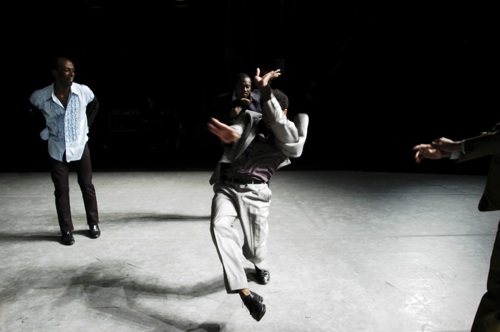
Ralph Lemon. “Come Home Charley Patton” from The Geography Trilogy. 2004. © 2010 Dan Merlo.
In 2009 Connie Butler invited me to be part of the 2010 On Line exhibition at MoMA, and to work in the Marron Atrium. Okwui Okpokwasili and I performed a duet, it was a remarkable experience because of how unmanageable it felt. The audience politic factor in particular; it wasn’t a theater, and it didn’t seem like a museum. It wasn’t something I completely understood, which excited me. So, I thought it might be a good place to pursue what was then the Blues project. I proposed the idea to Kathy Halbreich, who liked it and boldly got the idea in through the doors.
Danielle Goldman, in her writing for the Danspace Project blog on the recent Conversation Without Walls reflections on Some sweet day, described the concept more inclusively, as a kind of “fugitivity.” And I suppose that fits in the matrix. So I was working with a translation of this idea of blackness but primarily I was working with the question of being a curator versus an art-maker. I had this idea of bringing different artists, artists that I admired, into this complex container. I wanted to share a concept that is personal and has been generative to me, but one that might also be useful to a larger community.
MP: Did it work out the way you expected? Did your perception of what it was change from your initial vision of what you thought it might be?
RL: I had a lot of fun! It was also a lot of work, and much of my work was about discovering MoMA’s system, the precision and rigor of the place. The Atrium is not really a performance space, and certainly not a theater; there was a large learning curve for both of us. We had to figure out how to accommodate groups of performers without dressing rooms and without a wood floor, lights, etc. Sound and acoustics were an enormous issue.
A part of the curatorial team was specifically from the theater world to help translate a technical way of working within the MoMA system. The larger collaborative team from both worlds instrumentalized the idea; the whole was exceptionally supportive of the work. Eventually, I was able to just watch. After the performances, people would just hang out and talk. That was a surprise. Near the end I thought, we should have a portable bar, to wheel in and out, for the hanging out part.
MP: I never thought of that space as a place to hang out before. It was just a thru-way to get another room or another floor.
RL: I think that speaks to its publicness. There is a potential for exchange in that space, and the series seemed to open that up.
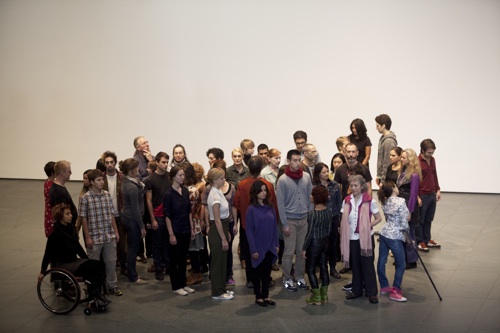
Performance of Steve Paxton’s State (1968) at The Museum of Modern Art, October 2012. Part of Some sweet day (October 15 to November 4, 2012). © 2012 Museum of Modern Art, New York. Photo by Julieta Cervantes.
MP: Steve Paxton said that MoMA should open up the space for dancers to experiment there.
RL: Yes, he proposed giving dance artists longer residencies in MoMA, to be in the building longer to make work. We didn’t have that kind of time, so Some sweet day felt more like an infiltration. So, yes, in the future for dance to become more realized in the space, artists should be able to spend more time there, so that they are having as much of a conversation with the space as possible, versus just enough time to propose an idea.
MP: Time is also necessary to understand the various audiences that come through MoMA, it’s a different world than the theater.
RL: There were three kinds of audiences, at least. The tourist art audience, the visual art audience, and the dance audience. Three very different gazes of looking at art, at least.
MP: Do you think that Some sweet day might have opened up a space for these different audiences to want to see more of what before might have been foreign?
RL: For what I would call the downtown dance audience, I think there was a breakdown of what they thought MoMA was, is. Maybe a breakdown of what has been perceived as a place of privilege, a place and privilege not completely theirs. A breakdown of some outsider status, perhaps. For the visual art world, that kind of viewing, lens, maybe they saw dance as relevant and part of their art discourse. Maybe. For that other random-like audience, the tourists, I think dance in the space remained a curiosity at best, like any other kind of art in the museum.
MP: I wondered in that context if the visual art viewers or tourist viewers were able to see dance as other than entertainment.
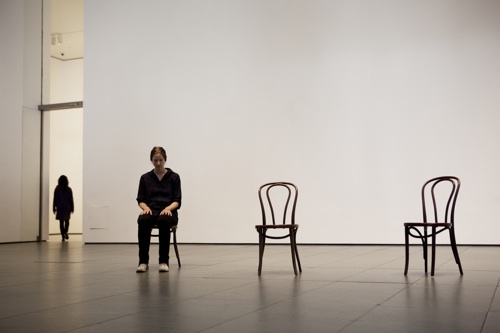
Performance of Steve Paxton’s “Satisfyin Lover”(1967) at The Museum of Modern Art, October 2012. Part of Some sweet day (October 15 to November 4, 2012). © 2012 Museum of Modern Art, New York. Photo by Julieta Cervantes.
RL: I think they did with particular works, like Paxton’s Satisfyin’ Lover, for instance. Because of its stillness, its perfect nothingness? But all art is entertaining on some level, making you think, stimulating one’s intellect or stupidity, entertaining a darkness, or delight, entertaining a spirit or arrogance.
MP: I wondered how the audience perceived the “Macarena,” performed in Jérôme Bel’s The Show Must Go On. Was it art or entertainment?
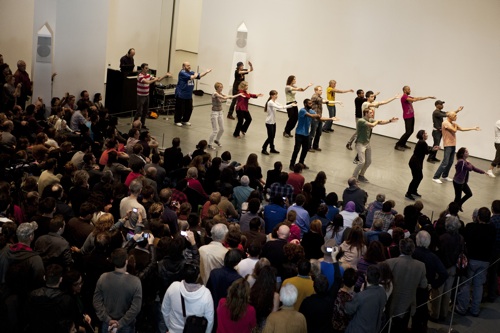
Performance of Jérôme Bel’s “The Show Must Go On” (2001) at The Museum of Modern Art, October 2012. Part of Some sweet day (October 15 to November 04, 2012). © 2012 Museum of Modern Art, New York. Photo by Julieta Cervantes.
RL: There’s that façade of dance or theater. It calls to mind a quotation from Roberta Smith on a Jeff Wall photography show a few years ago, something about the ‘awkward immediacy of theater.’ It’s immediate, but it’s not real. But what’s real about a beautiful object? Or about a painting that purports to be communicating something beyond its paint and canvas? The way we disregard these different creative processes is a little silly.
MP: How did you decide on the pairings of the artists, was it purposeful to situate two white male choreographers together, two black male choreographers together and two white female choreographers together?
RL: The pairings seemed obvious to me. Putting a Judson artist like Paxton next to a French conceptualist like Bel made sense. Then, Faustin Linyekula, who is Congolese, next to the American Dean Moss. They are both so ensconced in race and yet both working very much around it. Then, I thought of the contrast between a contemporary dance fixture like Sarah Michelson and a Judson and contemporary fixture like Deborah Hay. Those pairings just found themselves in my body somehow before they became public.
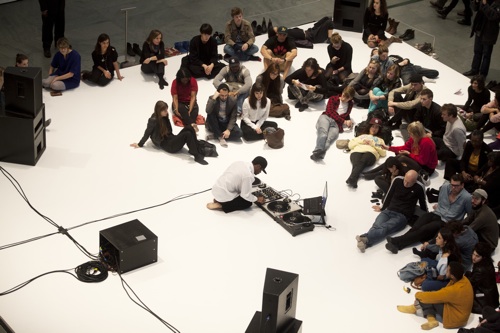
Kevin Beasley. “I Want My Spot Back.” The Museum of Modern Art, October 2012. Part of “Some sweet day” (October 15 to November 4, 2012). © 2012 Museum of Modern Art, New York. Photo by Julieta Cervantes.
Kevin Beasley, and his interstitial entry, was terrifying; there were a lot of complaints. The whole building was literally shaking from the reverberations of the music. He was sampling dead hip-hop artists from the 1990’s like Biggie Smalls and Tupac Shakur. It was a very black and very loud hour. But most visitors, I’m sure, just heard it as very loud, terrorizing. MoMA let it happen, as disruptive as it was. That instance crystallized for me this idea of black music as metaphor for some kind of American-ness. An invasive threatening under-rhythm, but also beautiful.
I thought all the works of Some sweet day broke some established spatial and programmatic code, but for me, Beasley’s I Want My Spot Back was the most transgressive. It was not a dance, though it was a performance. Kevin sculpted sound. He grew up with hip-hop, and he’s a DJ studying sculpture. For him, sound is material. He’s 23, so race is a different issue for him than it is for me. What is race when you’ve grown up with it being so ensconced in popular culture? Biggie Smalls and Tupac are wildly popular icons, in life and death. Jay-Z and Beyoncé are King and Queen of the world, not of black people, but of the world. So, it’s a very exciting time. We’re able to be fluid, and challenged, and destabilized.
MP: Do you think white people question their privilege, even if Jay-Z and Beyoncé are King and Queen of the world? Everyone in my generation grew up with hip-hop, and all the white people sing it, too.
RL: Like thousands of young white people screaming, “Hell! Yeah! Nigga!” They are really saying it, and they are really feeling it. On some level, they are actually believing it and identifying with it. That is totally absurd, but it’s also amazing.
MP: What are they identifying with?
RL: Its blackness. Not its black-peopleness, its blackness. Its acting-out, and its acting-out culture. Kanye and Jay-Z become the messengers. But then the radicalism becomes impotent at the same time. Once it has filtered through its black-peopleness, it becomes impotent. It becomes more inclusive, and less dangerous. Nigga becomes benign. But black people remain scary, a threat. Those who aren’t privileged, those who are suffering, impoverished, disenfranchised are still a danger to a world of privilege.
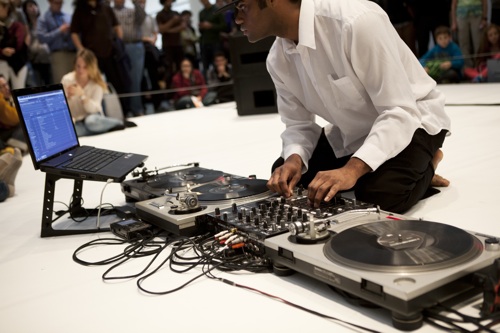
Kevin Beasley. “I Want My Spot Back.” The Museum of Modern Art, October 2012. Part of “Some sweet day” (October 15 to November 4, 2012). © 2012 Museum of Modern Art, New York. Photo by Julieta Cervantes.
MP: Each of the artists brought a unique form of transgression to the series, but I found that in order to fully understand how it figured into the work in the Atrium, I had to see the artists within their own contexts.
RL: They were all dealing with being outsiders in that space. None of them belonged in the Atrium, or they didn’t belong until they belonged. Fugitives. They had to create their own presence in a space not meant for them. They were all dealing with a “rightness” and “wrongness” in how they were using the space, and how their work was perceived. This brings up something for me about the art tourist audience I mentioned earlier. I saw something happen within that particular audience that really shifted their rhythm. Just being able to sit and be curious and see something live, that they experienced something in that space that was out of the normal rhythm seemed like a good thing. They also became part of a larger community, or an instant community that formed around the performances.
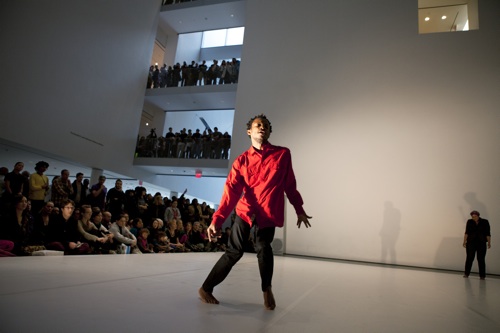
Performance of Faustin Linyekula’s “What Is Black Music Anyway…/Self-Portraits” (2012) at The Museum of Modern Art, October 2012. Part of Some sweet day (October 15 to November 04, 2012). © 2012 Museum of Modern Art, New York. Photo by Julieta Cervantes.
Part 2 of this interview can be followed on Critical Correspondence.

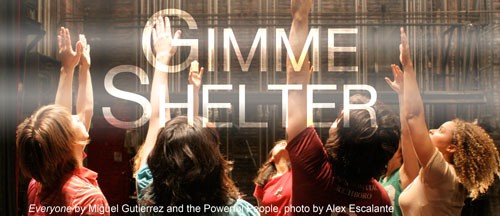



Pingback: Infiltrating the MoMA Atrium Part 2: Ralph Lemon in conversation with Marissa Perel on “Some sweet day” « Critical Correspondence